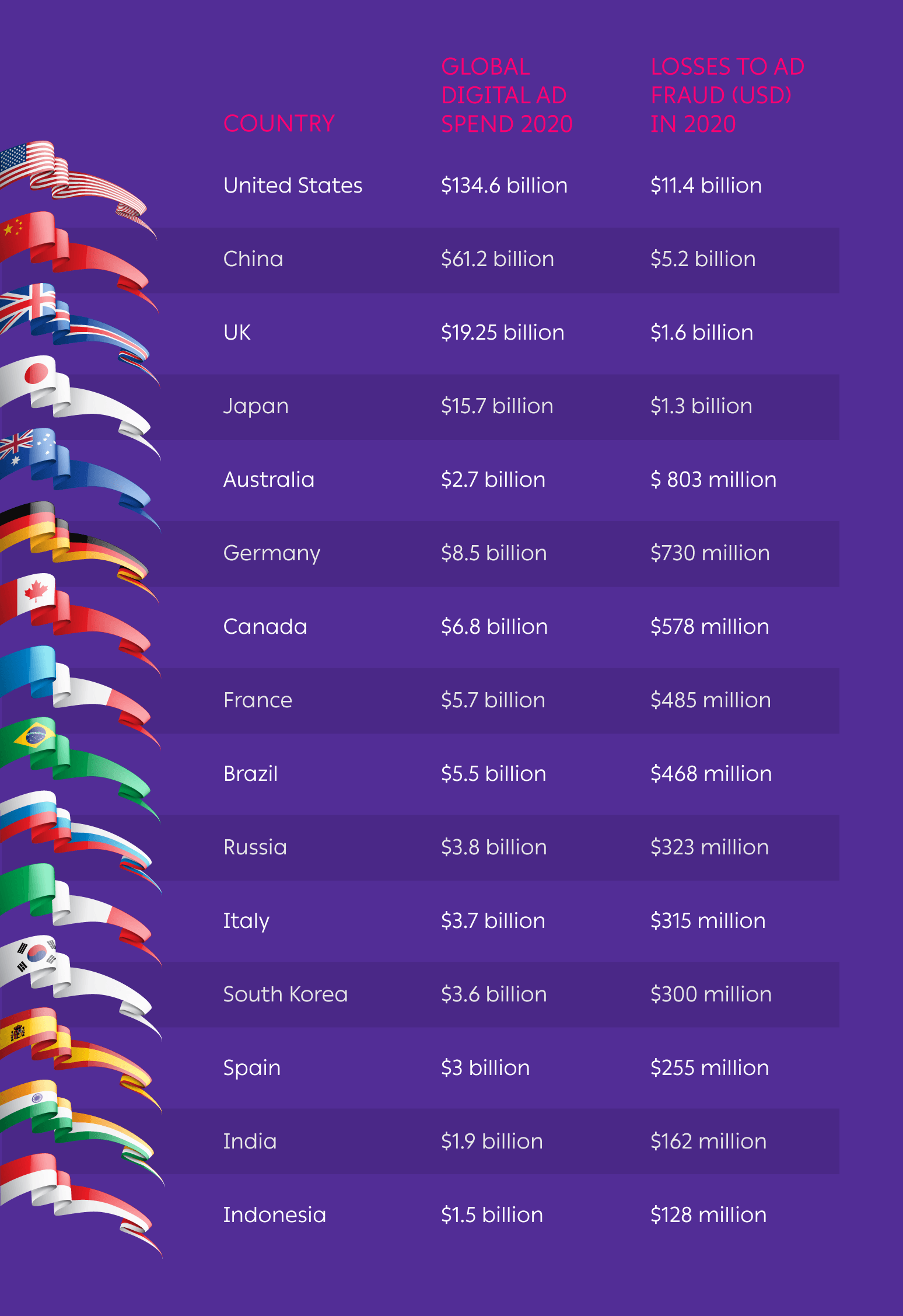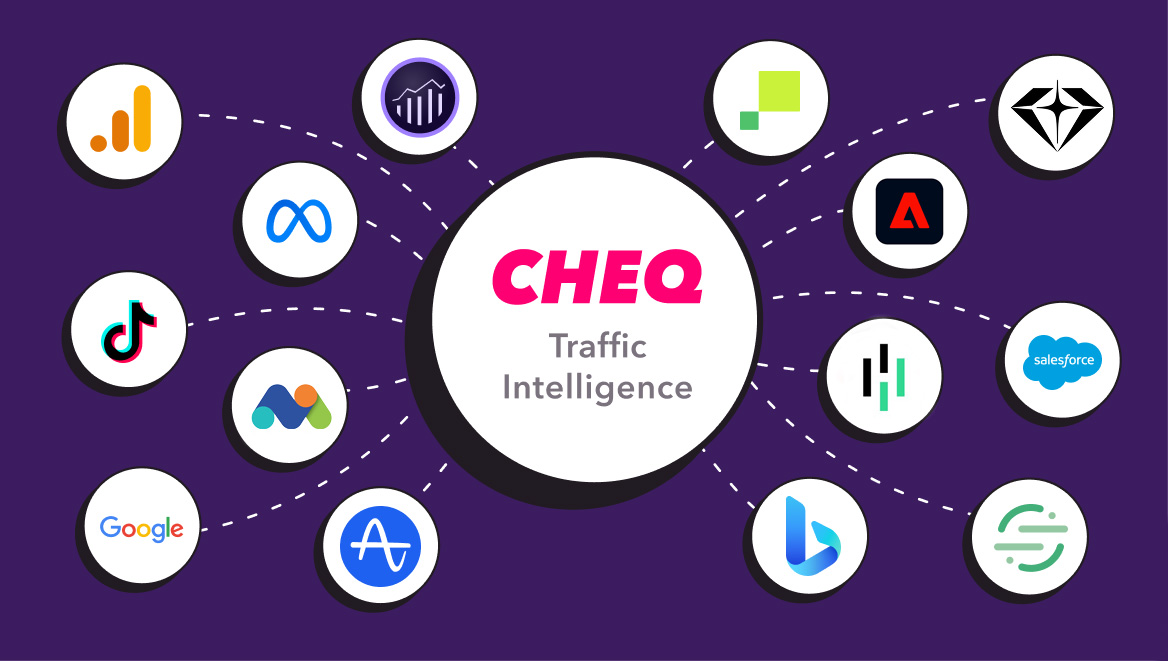The global growth of ad fraud in 15 countries
Jonathan Marciano
|Marketing | January 07, 2021

US, China, UK, Japan, Australia, Germany, and Canada see rising losses
Losses by digital marketers to ad fraud rose to $35 billion globally in 2020.
In this accompanying post, we analyze ad fraud losses in 15 countries, which are the biggest victims. The rising challenge of ad fraud comes as international trust busters seek to clean up online ad transparency, calling out the problems of bad actors hoovering up ad spend and the effects on the industry and wider society. The UK competition and Markets Authority, in a study into online platforms and digital advertising confirmed that “ad fraud is acknowledged as an industry-wide challenge and an issue that requires industry-wide solutions to address it”. Australia’s Competition and Consumer Commission, conducting an inquiry into AdTech, notes that “opacity may arise due to the growing complexity and number of suppliers and services involved in the ad tech supply chain and the ‘black box’ nature of some parts of the ad tech supply chain” cited as a breeding ground for fraud in our research. The US Federal Trade Commission reported back to Congress on the spread of bots affecting online advertising. They state that bots” use artificial intelligence and big data analytics to imitate real users posting content; the Department for Homeland Security concludes that they are becoming more prevalent and better at mimicking human behavior, such that their potential uses, for good and malicious purposes, are ever-expanding.”
Here, we see the economic losses for marketers faced with mounting losses from ad fraud in 15 countries.
10 Countries facing rampant ad fraud costs
1. UNITED STATES: $11.4 billion ad fraud losses
The biggest victim of ad fraud, unsurprisingly, is the United States. The biggest world spender on digital advertising spent $135 billion on digital advertising in 2020; however, a large chunk ($11.4 billion) was lost to ad fraud. In the US, in particular, a major digital outlay in 2020 was political campaigns. In the 2020 Presidential race, 13% of $1.3 billion in digital political spend was lost to ad fraud. This plays to the nature of digital political spending, where there is a requirement for full spending of campaign money by a set timeframe (the date of the election) with little accountability or post-mortem once the election has ended. Finally, ad fraud attacks further swelled due to a perfect storm of greater sophistication of bot attacks with minimal resources and opportunities presented during the COVID-19 crisis. Ongoing US court cases related to ad fraud include FBI action against alleged perpetrators of the Methbot ad fraud involving 1.7 million hacked computers to load falsified ads; Uber winning a $ 6 million settlement for alleged ad fraud, all the way down to smaller cases such as Las-Vegas based online golf equipment retailer Motogolf.com suing a competitor for malicious pay-per-clicking on their ads.
2. CHINA: $5.2 Billion ad fraud losses
It has been suggested that rates of fraud reach 30.7% in China, according to GroupM , the world’s leading media investment company. In 2020, the short seller, Muddy Waters, run by Carlson Block, set its sights on alleged ad fraud in the case of Chinese-based YY Live being bought by Baidu for $3.6 billion. Muddy Waters detailed ad fraud allegations about IPs that were bots, the use of VPNs, and several other examples of faked metrics. In another case, an ad fraud operation, nicknamed “RedEye,” generated fraudulent traffic through traffic exchange platforms using a combination of bots and human users. The case involved digital publishers with over 300,000 different URLs and apps connected through up to 99 different nodes that generated fake traffic, affecting brands including Apple, Procter & Gamble, GSK, Dior, and Chanel. Brands’ ads were shown appearing next to pornographic content on desktop and mobile through ad fraud in their campaigns.
To help combat the problem in March 2021, China’s Advertising Association (CAA) and the Trustworthy Accountability Group (TAG) – an advertising industry self-regulatory initiative, launched new international standards in the Chinese market.
3. UK: $1.6 billion ad fraud losses
In the UK, £1.2 billion ($1.6 billion) was lost to ad fraud in 2020. UK companies that have been snared by various frauds have called for more to be done to tackle the challenges. The Financial Times was hit by domain spoofing of its trusted brand, with the publisher estimating the value of a fraudulent inventory, across 10 ad exchanges to be $1.3 million a month. Decrying the incident, Anthony Hitchings, the FT’s digital advertising operations director, said: “The scale of the fraud we found is jaw-dropping. The industry continues to waste marketing budgets on what is essentially organized crime.” UK brand Virgin Media, among dozens of brands advertising on sites set up and populated by stolen content through the use of scraper bots, said: “We hope more can be done across the industry to clamp down on these instances of pay-per-con advertising fraud.”
Indeed, in 2020, the ISBA and PwC, in a study of UK advertising involving brands including HSBC, Walt Disney, and Unilever (each with 300 distinct supply chains), found that 15% of advertiser spend in the UK is completely unattributable, creating a markedly opaque supply chain. It notes that the data captured from a demand-side platform (DSP) for an impression is not equally captured on the sell side.
In setting out its views on the market problems of online advertising, the UK’s competition watchdog, the Competition Markets Authority, wrote in July 2020: “If problems in the digital advertising market mean that [publishers] receive a lower share of advertising revenues than they should, this is likely to reduce their incentives and ability to invest in news and other online content, to the detriment of those who use and value such content and to broader society.”
4. JAPAN: $1.3 billion ad fraud losses
Some 31% of advertising in Japan is digital, amounting to $15.7 billion annual spend in 2020 of which $1.3 billion is lost to fraud. The issue of ad fraud in Japan is slowly starting to be tackled. This has been promoted by outliers such as Cyber Communications Inc (CCI) owned by Dentsu, which found fraud rates around 7% on campaigns before adopting cybersecurity ad verification. Masatoshi Ito, President of the Japan Advertisers Association (JAA) Chairman of the Board at Ajinomoto Co, recently announced the launch of the “Advertiser Declaration on the Challenges of Digital Advertising“. The declaration features the eight “principles of partnership” around emerging industry issues that advertisers should address including ad fraud, brand safety, viewability and transparency in the supply chain. Yoji Inutsuka CHEQ’s Japan country manager said: “Despite a tumultuous time for marketers, digital advertising remains a crucial source of ad spending in Japan. In this situation, we see that fraudsters have ready access to the most advanced tools ever available to commit fraud at scale.”
5. AUSTRALIA: $803 million ad fraud losses
Australian marketers lost $803 million in 2020 due to ad fraud. To take one example, during the peak of COVID-19, click fraud rates in Australia jumped from 18% to 28%. Click fraud is carried out either by direct competitors or by organized criminals, with complex infrastructure set up to defraud multiple businesses, usually through the use of fake websites and automated bots.
CHEQ Australia regional managing director Mick O’Brien says: “We see a large part of crucial paid search spend is wasted on invalid clicks, which is both an economic loss for companies while also denying advertisers crucial data when bots, instead of humans, are clicking on expensive ads.” It therefore comes as no surprise that the Audited Media Association of Australia’s (AMAA) Media Trust Report has shown that both ad fraud and non-human traffic remain the biggest concerns among marketers and agencies. Linked to this (bots distort actual campaign performance), 61% of marketers said they struggled to show proof or performance, which was 54% for media agencies in Australia. The ACCC, Australia’s competition regulator, is continuing its probe into Australian online advertising in a bid to tackle opacity in the industry.
6. GERMANY: $730 MILLION ad fraud losses
Germany is set to lose $730 million to digital ad fraud in 2020. Arne Kirchem, Media Director for Unilever in DACH (Germany, Australia, and Switzerland), who sits on the German Advertisers Association, says he thinks the losses to ad fraud will continue to climb. He says: “As the share of digital spending rises from year-to-year, the total amount of money wasted grows also from year-to-year. It is a situation that can’t be accepted by any advertiser, no matter if the ad fraud rate is about 5% or even higher. We see even higher rates in the market, which causes at least irritation or more a lack of trust on advertiser’s side. There needs to be a joined industry initiative to get a clear view of the size of the problem and then take measures to erase it.”
7. CANADA: $578 MILLION ad fraud losses
In total, Canadian companies spent $6.36 billion USD on digital ad spending (54% of marketing budgets) with spend is set to rise to 7 billion USD by 2021. Of this, $578 million is lost down the ad fraud drain. Rates of click fraud in Canada are 13% of spend across paid search and paid social, reaching 20% for Canadian digital agencies. However, every online sector is affected by fraud. Justin Chapman, VP, CanScribe Career College, the first private online career college in Canada, says: “One of the biggest challenges for us in the education sector has been click fraud. We advertise in Canada exclusively. After a few months, I looked at where our clicks were coming from and was blown away at how many were outside of Canada. Not only did this cost us money in clicks, but it also cost us in time. Our marketing team was spending time trying to find a solution to this problem and our admissions team was spending time filtering through extremely low-quality leads and the high-quality leads.”
8. FRANCE: $485 million ad fraud losses
In France, marketers are also uniting against ad fraud: 15 French advertisers, including AccorHotels, Allianz France, and Renault signed a manifesto stating that their brands will give priority to Digital Ad Trust (DAT)-labelled websites in their digital spending. DAT is a label in France that certifies websites that commit to responsible advertising practices and covers areas like brand safety, viewability, ad fraud, user experience, and protection of personal data. It also refers to industry standards such as the Better Ads Standards and involves industry-certified verification tools. In France three broadcasters, France Télévisions, M6 and TF1, have also created a common standard for advertisers who want to buy inventory on their video-on-demand services programmatically in order to deal with ad fraud challenges.
9. Brazil: $468 million ad fraud losses
The growth of ad fraud opportunities in Brazil reflects the fact the country has seen among the largest spend growth in the world. Despite COVID-19 the Latin American advertising leader saw a 5% increase in digital ad spend in 2020. This equates to $5.5 billion in spend. Recent ad frauds discovered include a scheme to deliver millions of out-of-context (OOC) ads through a group of more than 240 Android applications on the official Google Play store, in which the majority (nearly 21 percent) of traffic came from Brazil. The rise of mobile fraud comes as mobile growth soars, with Brazil seeing 50% increase in app installations in 2020. In particular, Brazil has a higher rate of finance and shopping app installations. These non-gaming apps are more attractive to ad fraudsters.
10. Russia: $323 million ad fraud losses
IAB (Interactive Advertising Bureau) Russia shows that digital accounts for a 36% share of the market for advertising in the country. With rampant click fraud, Russian brands are particularly vulnerable with 70% claiming to use clicks as their main parameter for advertising effectiveness. Many ad fraudsters have originated from Russia including perpetrators in the “Methbot” case. In the world of click fraud, GoodGoogle is one of the more infamous Google Ads fraudsters operating on the Russian-language forums, as shown in a recent ClickCease report on the click fraud gig economy (ClickCease, a CHEQ company, provides a small business solution for thousands of small and medium-sized businesses). Using a combination of custom software and hands-on customer service, GoodGoogle promises clients the ability to block the appearance of competitors’ ads.
Finally, filling out the world rankings for ad fraud, Italy, in 11th place, sees $315 million in losses from ad fraud per year, based on 2020 spending. This is followed by South Korea ($300 million in ad fraud losses), Spain, ( $255 million), India ($162 million), and Indonesia ($128 million) complete the picture.
If you manage PPC or Paid Social ads, check our click fraud prevention solution that prevents ad fraud losses (whatever your country) across all Google, Facebook, LinkedIn, Pinterest, and Instagram campaigns.
P.S.
Want to protect your sites and ads? Click here to Request a Demo.














